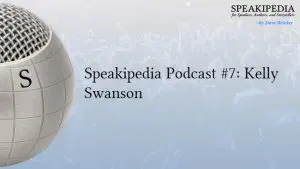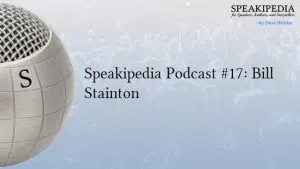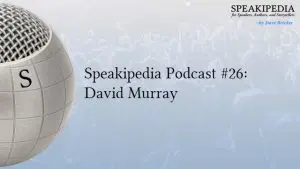 Dialogue presents challenges for writers. Some prefer to simply declare what was “said.” Many authors feel that “said” is both traditional and invisible:
Dialogue presents challenges for writers. Some prefer to simply declare what was “said.” Many authors feel that “said” is both traditional and invisible:
“I’m going to write some dialogue,” said Bill.
“I look forward to reading it, ”said Helene.
But this style is not invisible. Some narrator is telling us what happened—as if the characters spoke in some other time and place and we’re hearing a play-by-play of their conversation after the fact.“Said,” is past tense. Others object to the mindless repetition of “said, said, said.”
This latter objection is all-too-often countered by inserting an exhaustive list of words that fill in for the functional-but-dry “said”:
“Let’s try some sample dialog,” suggested Bill.
“I’ll give it a shot,” muttered Helene.
“What shall we talk about?”asked Bill.
“Doesn’t matter; this is just an example,” responded Helene.
“You really should take this seriously,” Bill admonished.
“Well, think of a topic, then,” Helene snorted. “How can we have a serious chat about nothing?”
As the writer runs out of synonyms, the narrative begins to take on unusual and unexpected colors that distract the reader from what’s being said. And if the dialogue is longer than a few pages, even writers with huge vocabularies will run out of synonyms and be forced to start recycling awkwardly. Mostly, the dialog gives the writing a bland, journalistic overtone.
Some writers avoid dialogue, placing the burden on the narrator to relate the story to the reader:
Once more. Say you are in the country; in some high land of lakes. Take almost any path you please, and ten to one it carries you down in a dale, and leaves you there by a pool in the stream. There is magic in it. Let the most absent-minded of men be plunged in his deepest reveries—stand that man on his legs, set his feet a-going, and he will infallibly lead you to water, if water there be in all that region. Should you ever be athirst in the great American desert, try this experiment, if your caravan happen to be supplied with a metaphysical professor. Yes, as every one knows, meditation and water are wedded for ever.
—Herman Melville, Moby-Dick
When characters are talking, ensure that the reader always knows who is speaking. At the same time, keep the narrator “off-camera” as much as possible so the reader feels in the room, listening to and watching the conversation.
Writers can take useful clues from film directors. If Bill is speaking to Helene, the camera might look at Helene over Bill’s shoulder. What facial expressions and gestures do the characters make that reveal their thoughts and feelings? Potent dialogue contains so much more than exchanged words. What’s unspoken is often the most powerful part of the conversation.
Bill took a long, deep breath. “I’m here to help. Rather than get upset, let’s rewind, pick a topic, and move forward together.”
Helene looked down. “You’re right. I’m sorry I jumped on you.”
“Water under the bridge, Helene. I’m over it.” He put his hand on her shoulder, lightly. “Tell me what you’re interested in—or what you ate for breakfast. I’m sure we can find a topic.”
Helene’s eyes brightened. “You know that little restaurant on the corner of 5th and Main? The one with the funny blue awnings where they always forget to turn the ‘we’re closed’ sign around?”
Bill smiled at Helene’s observations. He liked the way she picked out unusual details that anyone else would miss.
“They make this French toast with rum in the batter that you wouldn’t believe. The bread has nuts in it and they have real maple syrup and …”
Bill noticed the syrup stain on the ruffles of Helen’s white blouse and supressed a chuckle. Nuts and rum; that explains everything.
This dialogue is cinematographic. The narrator doesn’t need to tell us what the characters are saying; they’re capable of doing that on their own; that’s what the quotation marks are for. The narrator’s job is to fill in details that won’t come through in pure dialogue: pauses, breathing, eye and hand motions, body language, facial expressions, clothing. It’s not enough to hear the dialogue. If we can visualize it, we’re there with the speakers. The narrator is still with us—much like a stagehand is there with a bright spotlight—but we focus on where the light is pointed rather than on its source. The italics at the end offer Bill’s unshared thoughts. He doesn’t want to offend Helene by stating his conclusions out loud, but we’re privy to them all the same.
In the following dialogue from John Steinbeck’s The Grapes of Wrath, the material that’s outside the quotation marks is just as powerful as the verbal exchange.
The owner drummed his knee with his fingers. “Deputy sheriff comes on by in the night. Might make it tough for ya. Got a law against sleepin’ out in this State. Got a law about vagrants.”
“If I pay you a half a dollar I ain’t a vagrant, huh?”
“That’s right.”
Tom’s eyes glowed angrily. “Deputy sheriff ain’t your brother-‘n-law by any chance?”
The owner leaned forward. “No, he ain’t. An’ the time ain’t come yet when us local folks got to take no talk from you goddamn bums, neither.”
“It don’t trouble you none to take our four bits. An’ when’d we get to be bums? We ain’t asked ya for nothin’. All of us bums, huh? Well, we ain’t askin’ no nickels from you for the chance to lay down an’ rest.”
The men on the porch were rigid, motionless, quiet. Exh5ssion was gone from their faces; and their eyes, in the shadows under their hats, moved secretly up to the face of the proprietor.
Pa growled, “Come off it, Tom.”
Writing is design. Good dialogue contains more than an exchange of words. Effective prose transports the reader into the scene—something that’s nearly impossible unless you describe the scene and what the characters are experiencing. Having a character say what he’s thinking is easy. Having him show you what he’s thinking, sometimes without saying a word, is a hallmark of good writing.
Articles in the Writing is Design Series include:
Writing is Design: Avoid Bland Pronouns and Boring Verbs
Writing is Design: Avoid Writing Clichés for Better Prose
Writing is Design: Boring Words & Generic Descriptions — Not Nice!
Writing is Design: Eliminate THAT Fat From Your Writing
Articles in the Writing is Design Series include:
Writing is Design: Avoid Bland Pronouns and Boring Verbs
Writing is Design: Avoid Writing Clichés for Better Prose
Writing is Design: Two-Word Writing Clichés
Writing is Design: Boring Words & Generic Descriptions — Not Nice!
Writing is Design – Writing Dialogue: He Said. She Said.
Writing is Design: Eliminate THAT Fat From Your Writing
Writing is Design: Shy Away from Timid and Passive Writing





